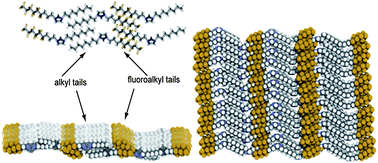Anisotropic ionic conductivity in fluorinated ionic liquid crystals suitable for optoelectronic applications†
Abstract
In this work, we report a library of thirteen fluorinated

Maintenance work is planned for Wednesday 1st May 2024 from 9:00am to 11:00am (BST).
During this time, the performance of our website may be affected - searches may run slowly and some pages may be temporarily unavailable. If this happens, please try refreshing your web browser or try waiting two to three minutes before trying again.
We apologise for any inconvenience this might cause and thank you for your patience.
* Corresponding authors
a
NFMLab – D.C.M.I.C. “Giulio Natta”, Politecnico di Milano, Via L. Mancinelli 7, 20131 Milano, Italy
E-mail:
pierangelo.metrangolo@polimi.it, giuseppe.resnati@polimi.it
Fax: +39 0223993180
Tel: +39 0223993041
b
Clarendon Laboratory, Department of Physics, University of Oxford, Parks Road, Oxford, UK
E-mail:
a.abate1@physics.ox.ac.uk
Tel: +44 (0)1865272354
c Center for Nano Science and Technology@PoliMi, Istituto Italiano di Tecnologia, Via Pascoli 70/3, 20133 Milano, Italy
d Dipartimento di Fisica, Politecnico di Milano, Piazza L. da Vinci 32, 20133 Milano, Italy
e TRE Tozzi Renewable Energy SpA, I-48010 Mezzano, RA, Italy
f Department of Chemistry, University of York, Heslington, York YO10 5DD, UK
g Molecular Materials, Department of Applied Physics, Aalto University, School of Science, P.O. Box 15100, FI-02015 Espoo, Finland
In this work, we report a library of thirteen fluorinated

 Please wait while we load your content...
Something went wrong. Try again?
Please wait while we load your content...
Something went wrong. Try again?
A. Abate, A. Petrozza, G. Cavallo, G. Lanzani, F. Matteucci, D. W. Bruce, N. Houbenov, P. Metrangolo and G. Resnati, J. Mater. Chem. A, 2013, 1, 6572 DOI: 10.1039/C3TA10990A
To request permission to reproduce material from this article, please go to the Copyright Clearance Center request page.
If you are an author contributing to an RSC publication, you do not need to request permission provided correct acknowledgement is given.
If you are the author of this article, you do not need to request permission to reproduce figures and diagrams provided correct acknowledgement is given. If you want to reproduce the whole article in a third-party publication (excluding your thesis/dissertation for which permission is not required) please go to the Copyright Clearance Center request page.
Read more about how to correctly acknowledge RSC content.
 Fetching data from CrossRef.
Fetching data from CrossRef.
This may take some time to load.
Loading related content
